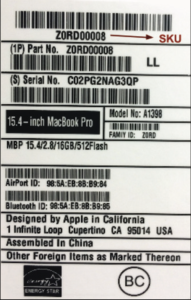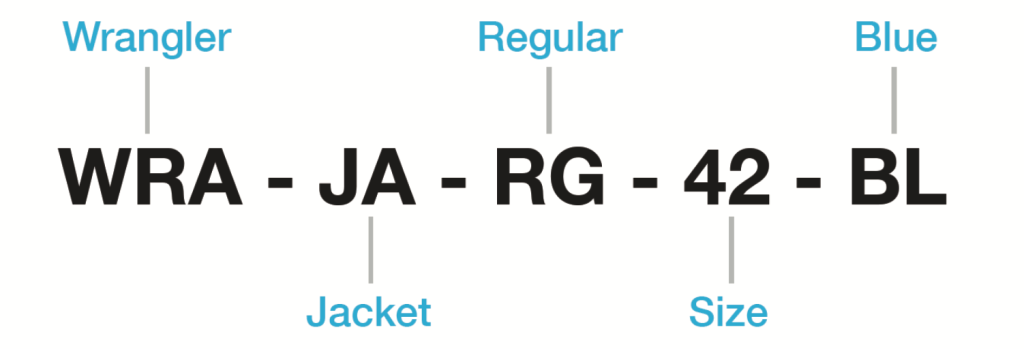In this white paper, we will help the reader to understand what a Stock Keeping Unit is, and why it is so important. We will start off by looking at SKU design and providing some examples of how they can be used. We will then go on to outline best practices for SKU generation, and examine a few common anti-patterns of SKU design.

Introduction
SKU (pronounced “skew”) is an acronym for “stock keeping unit,” and simply put, denotes the smallest selling unit of a product or service. SKUs account for the amount of product in inventory, tracking how many units of billable entities are sold. They are used internally by warehouses, fulfillment centers, trade customers, marketplaces, catalogs, and e-commerce platforms among others, and provide a number of benefits. SKUs allow the relationships between products to be more easily recognized, and users can print labels that display the SKU as either human-readable or as a barcode for the purposes of scanning (shown in the picture example below).
Products often come in a variety of models or styles, and while each has its own SKU, SKUs are not to be confused with the model number of a product. Model numbers and other attributes are often included in all or part of an SKU. Practices vary from company to company, and many businesses use part numbers, product codes, and item IDs, all of which are distinct from SKUs. Always be sure to distinguish between SKUs and other identification numbers when designing SKU numbers.

SKU on barcode
Designing SKUs
Before you start labeling SKUs with shortened product names or unique serial numbers, it is essential to take a step back and determine the data that will help you to design your SKUs most efficiently
Here are a few essential data points to be considered:
- What is the unique count of products you are dealing with?
- Does your company manufacture the products, or are they supplied by a vendor?
- Do you have the option to replace manufacturer SKU numbers with your own retailer SKUs?
- Is there a near-future possibility for the merging or acquiring of related businesses that will significantly change the products you carry?
The above questions will help you draw some high-level boundaries for the formulation of SKU numbers. All businesses have different needs, so it’s best not to limit yourself to these factors
You can make some judgments, for example…
Example 1: SKU numbers between 6 to 8 characters in length will suffice.
OR
Example 2: SKU numbers for a specific vendor start with an “A”, while for all other vendors they start with a “B”.
Successful inventory management systems assign a unique SKU for each product and for each of its variants. Different models or flavors of the product have independent SKUs, as do packages that bundle a number of related products. This has clear advantages: it allows merchants to track whether blue shirts are selling better than green shirts, for one simple example When designing an SKU, the idea is for the SKU to be useful, and to make sense to all parties involved in the handling of your items. For SKUs to work correctly, they must be assigned to each and every variation of a product. Thus, for every change in color or size, a unique SKU must be assigned.
Customers buy products based on choices at the attribute level. If you cannot gather demand intelligence at this level, you are out of touch with your customer.
It might seem obvious, but customers do not buy SKUs; they don’t know SKU numbers, nor do they care. Meanwhile, knowing what SKU attributes customers are buying can dramatically improve your demand response, allowing you to forecast demand at the attribute level – the level at which customers are buying. If you know what attributes are selling together, you can easily implement an automated recommendation engine, giving your sales reps the ability to make recommendations to the customer during the shopping process. This is probably the most powerful thing about understanding what attributes customers are buying. When dealing with customers, your salespeople benefit immeasurably from knowing what similar customers purchase. It couldn’t be any simpler: salespeople are your customers’ trusted advisors, and this information allows them to make better recommendations. That leads to happier customers, translating to higher sales repeatability. Smarter salespeople, better service, and higher sales, all from the data gleaned from a simple SKU.
An SKU usually includes details such as manufacturer, product description, material, size, color, and packaging, and may even include details about the warranty.
As an example, the SKU assigned to a Wrangler Jacket (WRA-JA-RG-42-BL) is diagrammed below:

Ideally, the SKU code is extendable; for example, if the product is typically purchased by the trade-in cases, the SKU for a case of Wranglers should be something like “WRA-JA-RG-42-BL-C30.” In this case, the “C” stands for case, followed by the number of units in that case. Below, we’ve provided some examples to illustrate a few different variants of SKU.
If you’re selling ink pens in three different colors, the SKUs might look something like this:
Ink Pen, Red, Model no.1 = IP01-R
Ink Pen, Blue, Model no.1 = IP01-B
Ink Pen, Green, Model no.1 = IP01-G
In this example, we have used the color variant, which distinguishes the items, as the last value in the SKU. By suffixing the SKU with the variant, we make the SKU easy to comprehend while still grouping together all ink pens with IP01 for ease of use.
For a slightly more complex example, we’ll add a few more variants. Season, product name, product type, size, and color have all been incorporated into the below SKUs.
Summer 2015, Cotton Tee, Small, Red = S15T-COT-RS
Summer 2014, Cotton Tee, Medium, Red = S14T-COT-RM
Summer 2012, Lady Tee, Small, White = S12T-LAD-WS
Summer 2012, Lady Tee, Large, White = S12T-LAD-WL
Best Practices
Now that you understand SKUs, let’s take a look at some best practices and tips for enterprises and merchants who want to create SKUs for their products
- To create a system that’s easy to work with and uses your own SKU numbers, you can get away with a much shorter SKU number, but not so short that it
can get confused with quantity; this speeds up the process of data entry and inventory management and helps suppliers to track more efficiently. Using the SKU number to describe your product in too much detail will only make your numbers longer and more complicated, and you can save most of that information for the item description As seen in our earlier example, instead of something like “WRANGLER-JACKET-REGULAR-42SIZE-BLUE,” a more sensible way to approach an SKU is “WRA-JA-RG-42-BL ” - Using alphanumeric SKUs will help you to distinguish them from other numbers, limiting their overall length and greatly increasing the number of possible item numbers. Starting SKUs with letters makes them easier to discern and sort in spreadsheets, and to sort during receiving, stocking, and picking. For example, if you were creating an item number for “White, Chocolate”, you might create the number “CHO101”, with “Dark, Chocolate” being “CHO102”, etc. If you want to create a unique SKU for every item in the shop, making SKUs human-readable will help everyone, and result in fewer errors. Looking at the SKU S129-56CB tells you nothing, but one look at an SKU like SUZUKI-ZX-150-01 will tell you what kind of product it represents, more or less When deciding the amount of information to include, the SKU designer must decide how much detail is necessary to fulfill the needs of the business. If the business requires that a salesperson or stock person be able to identify an item just by looking at the SKU number, that may justify a longer, more elaborate SKU.
- Qualities in an SKU should be listed according to the natural hierarchy of a product; following this rule, an iPhone’s qualities would be listed as iPhone, 5S, Black. Here the alphanumeric “IP-5S-BL” would be the right choice because it displays the most important distinguishing attributes first.
- One good technique for creating SKUs is using the cascade method, in which SKUs are logically decipherable. For example, suppose you are planning to sell electronic equipment from different brands. To create a cascade chart for your products, start by taking the largest set of information about an item (in this case, “Electronic Equipment”) and call that set ‘E’. Then you take the next most relevant subset, for example, “Laptops,” and call that set “L”. Then comes the brand, and after that comes the model, and so on. Keep adding attributes until you can reliably identify that particular laptop in your warehouse using only the SKU code Stop adding attributes once this unique identification is possible. As an example for Item “Dell Inspiron 15 4000 Series” the SKU number can be ELDI-15-4000S.
Antipatterns of SKU creation
Once your SKU definition is in place, 75% of the cost structure and efficiency of your supply chain have been fixed. Your supply chain operates under the assumption that the SKU definition is correct. What does this mean? Simply, this means that
if you utilize two SKUs with slightly different attributes that could have been consolidated into one, the supply chain will suffer that cost and inefficiency. That means it’s crucial for the SKU definition to be optimized before you send it into the supply chain Let us now discuss a few anti-patterns which you should take care to avoid when designing SKUs.
- Do not use a manufacturer’s SKU for your SKU number. These numbers are often too long and cryptic Plus, if you switch suppliers or the manufacturer changes their number, the SKU becomes meaningless to your organization.
For example, when referring to a “27 oz. White Gloss Dry Oil Paint”
- Manufacturer A uses SKU number “27OZWHGLDOPDULUX”
- Manufacturer B uses SKU number “DRYOILPAINTGL-NEROLAC-27”
- Manufacturer C uses SKU number “ASIAN-798ML-DOPG”
The business using this paint may buy the product from any of those manufacturers because each supplier manufactures the SKUs to the same specification. The user doesn’t want to utilize any of those manufacturer’s SKU numbers to identify this product, because it would imply that one manufacturer is acceptable and the other ones aren’t; moreover, the user wants to employ a consistent format for all of its SKUs As a solution, the user devises its own SKU numbering system, resulting in a new SKU number of “WH-GL-DR-OP-27.” This way, a retailer remains flexible enough to change manufacturers or wholesalers without the hassle of a system overhaul.
- Using nonstandard characters like quotes, parentheses, and ampersands can confuse people and software alike For example, using a comma in your item number might make it look like a quantity or price. You should also avoid slashes “/“ or accents (á, é, í, ö, ù, etc.) if possible. In theory, these characters may be compatible with your shopping system, but a third-party add-on might not be so well written. In Excel, the use of a “/” can result in your SKU number being formatted as a date. Likewise, the use of certain symbols (<, > and *) can result in unintended outcomes when moving data between systems. Characters like $ and @ are too confusing, and a notorious source of formatting errors. As a rule, it is best to keep SKUs alphanumeric; if you have to use nonstandard characters, make sure you have done due diligence to be certain they will never cause a problem.
- The shopping system is a computer-based system, and computers don’t always like spaces; more precisely, the people who program computers don’t always handle the processing of spaces correctly. Consequently, you should never use spaces in an SKU; use dashes (-) and underscores (_) as separators instead.
- Never start an item number with a zero, and avoid using letters (like I, O, and L) that can be confused for numbers, either by humans or software. Misreads can also be avoided by writing in uppercase and utilizing common fonts such as serif.
- Most importantly, always consider SKU numbers to be “dumb” when it comes to programming. Often programmers attempt to derive information by splitting or parsing SKU numbers; this can result in scalability challenges, as any change in SKU structure will impact the entire system It is crucial to educate your developers to never rely on SKU numbers to drive any programming logic.
It’s not a formal science, but before you start adding products to a shopping system you should decide on the best format for your SKUs.
Conclusion
In the eCommerce world, product labeling is crucial, particularly SKUs. Businesses should take proactive steps to eliminate SKU numbering bottlenecks, such as too many SKUs, improper numbering, and overly long numbers. They should adopt best practices now so that in the future they can add new products seamlessly, acquire new businesses, and simplify end-to-end inventory management.
Who We Are
Nisum enables transformation for industry-leading brands: we know how to build strong emotional bonds between B2C clients and customers via smart technology solutions.
Nisum is a global consulting firm headquartered in Southern California. Founded in 2000 with the customer-centric motto, Building Success Together®, we’ve grown to comprise over 1,400 consultants, and 8 offices across the United States, India, Chile, and Pakistan. Our philosophy and deep technical expertise result in integrated solutions that deliver real and measurable growth.
Whether you’re a hot start-up or a major global brand, our approach is the same: forge the most powerful connection possible between people, processes, and products to achieve unparalleled success. At the intersection of business and technology, Nisum has everything you need to grow your organization. From Strategic IT Planning, Agile Enablement, and Business Process Engineering to Application Development, Test Automation, and DevOps, Nisum has you covered. We specialize in building Adaptable Back-End systems such as Order Management, Inventory, and eCommerce to facilitate true omnichannel success for our customers.
Nisum strongly believes in an organizational culture that is open, transparent, and progressive. We encourage creativity and innovation and consciously maintain an environment that is conducive to positive employee growth, learning, and performance.
Disclaimer: Nisum Technologies, Inc.’s white paper is made available for educational purposes only, as well as to give you general information and general understanding regarding Agile and Agile Next Door Models. The information herein is not advice and does not create any obligations, relationships, or duties on the part of Nisum Technologies, Inc. This white paper is provided “as is” and with no guarantees, representations, undertakings, or warranties whatsoever, including any warranty of merchantability, fitness for any particular purpose, or any warranty otherwise arising out of any proposal, specification, or sample.
The contents of this white paper, the names Nisum Technologies, Inc. and Agile Next Door, the logos and artwork used herein, are protected by the copyright, trademark, and intellectual property laws of the United States and other jurisdictions. No license, express or implied, to any intellectual property rights is granted or intended hereby. You may print a copy of any part of this white paper for your own use and reference, but you may not copy any part of this white paper for any other purpose, and you may not modify any part of this white paper. You may include any part of the content of this white paper in another work, whether printed or electronic, or another form, or include any part hereof in another website by linking, framing, or otherwise only if you provide all proper credits and references to Nisum Technologies, Inc.



